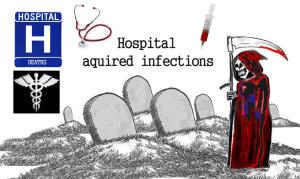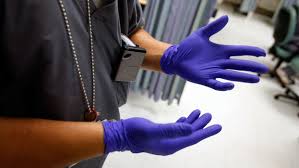Category Archives: Patient Safety– infections
Our Hospitals are Killing us, But Where’s the Outrage?
By Bob Aronson
This blog is dedicated to friends Kerry and Marsh Wick. Marsh, who underwent surgery in a local hospital, contracted an infection while there and died a while back. His wife Kerry, who was constantly at his side hopes that a more informed public will lead to fewer such cases.
Most of us still believe that hospitals are places that help the sick and dying get well. But are they? If you look at the most recent patient safety data one can’t help but arrive at the conclusion that there are safer places to be than hospitals. Here are some sobering facts.
Preventable medical errors are the No. 3 killer in the U.S. – following only heart disease and cancer – and claiming 400,000 lives a year.
400,000 people die each year in American hospitals due to preventable errors. Preventable errors — but there is no public outrage, it doesn’t lead the news each night and no politician is using that issue to get elected.
Ok, If that number doesn’t shock you, let’s put it in terms that will. The Airbus A380 is a double-deck, wide-body, four-engine jet airliner and is the world’s  largest providing seating for 525 people in a typical three-class configuration. In order to kill 400,000 passengers a year, 761 of these monstrous jets would have to crash every year…761, that’s over two a day. There aren’t that many A380s in the world. Probably never will be.
largest providing seating for 525 people in a typical three-class configuration. In order to kill 400,000 passengers a year, 761 of these monstrous jets would have to crash every year…761, that’s over two a day. There aren’t that many A380s in the world. Probably never will be.
So if planes were falling out of the sky at that rate, would there be congressional investigations, demonstrations in the streets, charges of criminal misconduct and airlines going out of business faster than you can say your own name. Pilots, co-pilots, airline executives, airline mechanics, air traffic controllers and even airport managers would be going to jail, but because that same number of people die due to errors in hospitals there is virtually no public outrage. Maybe old Uncle Joe Stalin who killed millions of his own people had it right when he said, “One death is a tragedy; a million is a statistic.”
If this was happening to airplanes it would be a lead story on every newscast and in every newspaper every day. So don’t you think just a little outrage is in order? 1,000 of our friends and neighbors die every day from preventable yes, preventable causes. But, if the cost of human life doesn’t get your attention, how about this. Preventable medical errors cost you and me over one trillion dollars a year. Yes, that’s trillion with a T, a thousand billion.
Killing patients at the rate of 400,000 a year has caused preventable medical errors to become the third leading cause of death in the United States, right behind heart disease and cancer.
So you likely are asking yourself, “Just exactly what is a medical error?” Well, there are thousands of them. I’ll give you just a few and you’ll soon realize that if you can imagine it, it likely has happened.
- Treating the Wrong Patient. If your identity gets mixed up with someone else’s, you can get the wrong medications or even the wrong surgery.
- Surgical Souvenirs. Surgical tools or other objects are left inside people after surgery far more often than you’d like to think.
- Air Bubbles in Blood. If the hole in your chest isn’t sealed correctly (airtight) after a chest tube is removed, air bubbles can enter the wound and cut off blood supply to your lungs, heart, kidneys and brain — a life-threatening event.
- Operating on the Wrong Body Part. It can happen if a surgeon misreads your chart, or if the chart is incorrect.
- Infection Infestation. Hospital-acquired infections (HAIs) are alarmingly common. Many people are admitted infection free, but partially because of antibiotic resistant bugs and partly because of sheer carelessness many of them acquire several infections and far too many die as a result.
Ok…you got the idea. Pretty gruesome, huh? So let’s talk about infections, the point of this blog.
I am the retired founder of the over 4,000 member Facebook support group, Organ Transplant Initiative. Recently during a discussion of HAIs, one of our members posted this horror story, unlike so many others he lived to tell it.
“Back at the time of my rapidly progressing illness and eventual transplants I went into the hospital with ONE infection acquired from contaminated soil it’s believed. After being in a local hospital for over a month I had no less than 15 other bacterial and fungal infections. Some acquired while being operated on. That particular hospital was cited for their infection issues too. One of the things uncovered was they were using mesh for hernia type repairs and then autoclaving the unused portion and repackaging it. That is absolutely forbidden.”
operated on. That particular hospital was cited for their infection issues too. One of the things uncovered was they were using mesh for hernia type repairs and then autoclaving the unused portion and repackaging it. That is absolutely forbidden.”
The September 2015 edition of Consumers R eports Magazine includes a major report on HAIs. This is a story everyone ought to read and soon. I will report some of my personal research findings later but CR did such a good job of framing the issue, I’ve included the first couple of paragraphs here.
eports Magazine includes a major report on HAIs. This is a story everyone ought to read and soon. I will report some of my personal research findings later but CR did such a good job of framing the issue, I’ve included the first couple of paragraphs here.
The Rise of Superbugs
“In the ongoing war of humans vs. disease-causing bacteria, the bugs are gaining the upper hand. Deadly and unrelenting, they’re becoming more and  more difficult to kill. You might think of hospitals as sterile safety zones in that battle. But in truth, they are ground zero for the invasion.
more difficult to kill. You might think of hospitals as sterile safety zones in that battle. But in truth, they are ground zero for the invasion.
Though infections are just one measure of a hospital’s safety record, they’re an important one. Every year about 700,000 people in the U.S. develop infections during a hospital stay, and about 75,000 die with them, according to the Centers for Disease Control and Prevention (CDC). That’s more than twice the number of people who die each year in car crashes. And many of those illnesses and deaths can be traced back to the use of antibiotics, the very drugs that are supposed to fight the infections.”
What’s shocking is that the harm caused by these infections is mostly preventable. The CDC (Centers for Disease Control and Prevention) in Atlanta, Georgia says healthcare facility surveys indicate a grave situation that is getting worse (HAI)prevalence survey).  Based on a large sample of U.S. acute care hospitals, the survey found that on any given day, about 1 in 25 hospital patients has at least one healthcare-associated infection. There were an estimated 722,000 HAIs in U.S acute care hospitals in 2011. About 75,000 hospital patients with HAIs died during their hospitalizations. More than half of all HAIs occurred outside of the intensive care unit.
Based on a large sample of U.S. acute care hospitals, the survey found that on any given day, about 1 in 25 hospital patients has at least one healthcare-associated infection. There were an estimated 722,000 HAIs in U.S acute care hospitals in 2011. About 75,000 hospital patients with HAIs died during their hospitalizations. More than half of all HAIs occurred outside of the intensive care unit.
This is the official U.S. Government estimate of infections occurring in Acute Care Hospitals in the United States.
Pneumonia 157,500
Gastrointestinal Illness 123,100
Urinary Tract Infections 93,300
Primary Bloodstream Infections 71,900
Surgical site infections from any inpatient surgery157,500
Other types of infections 118,500
Estimated total number of infections in hospitals 721,800
To read the full report, please visit: CDC HAI Prevalence Survey
Magill SS, Edwards JR, Bamberg W, et al. Multistate Point-Prevalence Survey of Health Care–Associated Infections. N Engl J Med 2014;370:1198-208.
- And here is some other startling information. Did you know you are at risk even while in the shower? Studies indicate that moisture-loving bacteria living in showerheads include huge populations of potential pathogens and, they can be quite different from their relatives who live on shower curtains just a few feet away.
- A common misconception is that germs have very short life spans, but that’s simply not true. Drug-resistant staph germs can live for up to a week on some common furniture fabrics. Strep germs can survive for months on a dry surface. You simply cannot overdo cleaning or washing your hands. Who knows whose life you might save by doing so…it could be yours or someone very dear to you.
Raw numbers are cold and impersonal, the human side of the equation is anything but. Here are but a few real experiences that were posted on Facebook’s Organ Transplant Initiative support group
- On my Father’s death certificate, it actually says “Health Care Aquired pneumonia”.I asked my doc what that’s all about (Dad died from complications from cancer) He said that more and more these days, they are putting that on death certificat
 es because they are required to by law.
es because they are required to by law.
I got C-DIFF (Clostridium difficile colitis is an infection of the colon) and I’m in good health, one year ago this month I was in hospital for 10 days- in the ICU for 3. They couldn’t figure it out- infectious disease came in every day- it’s scary out there!!!
***Editor’s note. The law requires healthcare facilities to report hospital or healthcare acquired infections (HAI) and to include them on the death certificate if, in fact, they caused the death. The doctor’s explanation that they are required to do that is fudging the facts. They are only required to do that if an HAI actually was the cause of death. No healthcare facility likes talking about a problem that may be one of their own making, so downplaying it as a government requirement removes them of complicity.
- My husband was so deconditioned by the time he was able to be released post-transplant, that he had to go to an LTAC (Long Term Acute Care Hospital…aka as “hell”) At one point I told the person who called herself a nurse that he had managed to live, contrary to everyone’s expectations, and survive a liver transplant, and now “they” were going to kill him through neglect). Sadly, this is one of the circumstances that very ill transplant patients face. My only advice is be very vigilant. Take notes. Take pictures. Ask questions. Keep a journal. But for the attention of the ONE full-time physician and the contracted therapy staff, I’m really not sure he would have survived there.
Here are some examples of preventable contagion.
- A cleaning person enters your hospital room, puts on gloves and empties the trash. The trash could include old dressings contaminated with various bodily fluids and other infectious material. Then without
 changing gloves starts a new box of facial tissue and opens rolls of toilet paper and paper towels. That worker has just used the same gloves on everything he/she touched — and those items will then be used on your face and other sensitive areas.
changing gloves starts a new box of facial tissue and opens rolls of toilet paper and paper towels. That worker has just used the same gloves on everything he/she touched — and those items will then be used on your face and other sensitive areas.
- Also, consider this. How many times have you seen a urinal sitting on the bedside table that swings over the bed? That table is where they place your food.
- As these infections become more common it is incumbent on all of us to be more aggressive in demanding better infection control procedures. When you see an infraction, report it to the offending person’s supervisor. Hospital workers must follow strict hand washing procedures, change gloves often, clean flat surfaces more than once a day and NEVER allow urinals to come in contact with any other human especially those who are untrained and unprotected. As for patients, we had better use every precaution we can and the best of all of them is frequent hand washing.
Hospital Acquired Infections are a very real and constant threat, but prevention efforts appear to be paying off. The numbers aren’t big yet, but it should come as a relief to many that they are headed downward. By clicking on the following link you can get a detailed summary of the progress being made in the fight against HAIs.
HAI Progress Report
The CDC National and State Healthcare-Associated Infections Progress Report is a report that gives a closer look at the healthcare-associated infections (HAIs) most commonly reported to CDC using the National Healthcare Safety Network (NHSN). This is an annual report that describes national and state infection prevention progress.
The current report is based on 2013 data. On the national level, the report includes these highlights.
 A 46 percent decrease in CLABS (Central Line Associated Bloodstream Infections)between 2008 and 2013
A 46 percent decrease in CLABS (Central Line Associated Bloodstream Infections)between 2008 and 2013
A 19 percent decrease in SSIs related to the 10 select procedures tracked in the report between 2008 and 2013 (An SSI is an infection that happens after surgery affecting the part of the body where the surgery was performed. Some SSIs are superficial skin infections, while others are more serious and involve tissue under the skin or organs)
- A 6 percent increase in CAUTI between 2009 and 2013; although initial data from 2014 seem to indicate that these infections have started to decrease (CAUTI = Cather Associated Urinary Tract Infections).
- An 8 percent decrease in hospital-onset MRSA bacteremia between 2011 and 2013 (Methicillin-Resistant Staphylococcus Aurens)
- A 10 percent decrease in hospital-onset C. Diff infections between 2011 and 2013
While blogs like this can shine a spotlight on certain problems, we cannot even begin to give you all the information you need so you can decide which hospital is best for you. All we can do is offer you information that will lead you to the information you seek.
There are several organizations that gather information on Patient Safety for nearly every hospital in America. Some, like Consumer Reports require you to subscribe before giving you access. Others offer you access to a point and then place conditions on further cooperation on their part. If you Google “Compare h ospital patient safety records” you’ll get plenty of hits to explore. A warning; The process can be time consuming, confusing, frustrating and may even result in inaccurate information. You may even have to do some studying in order to understand the information you find.
ospital patient safety records” you’ll get plenty of hits to explore. A warning; The process can be time consuming, confusing, frustrating and may even result in inaccurate information. You may even have to do some studying in order to understand the information you find.
I did much of what I suggested to you. It took many hours and I cannot guarantee accuracy. I tried hard to achieve that goal but when there are as many disparate sources of information as there are on this particular topic it all boils down to an educated crap shoot.
One of the best resources I found for comparing hospital patient safety records is this one. http://tinyurl.com/q3gytkz but if you find it inadequate and not meeting your needs, then look around, there are plenty of other resources.
-0-
 Bob Aronson of Bob’s Newheart is a 2007 heart transplant recipient, the founder of Facebook’s over 4,200 member Organ Transplant Initiative (OTI) and the author of most of these donation/transplantation blogs. You may comment in the space provided or email your thoughts to me at bob@baronson.org. And – please spread the word about the immediate need for more organ donors. There is nothing you can do that is of greater importance. If you convince one person to be an organ and tissue donor you may save or positively affect over 60 lives. Some of those lives may be people you know and love. You can register to be a donor at http://www.donatelife.net. It only takes a few minutes. Then, when registered, tell your family about your decision so there is no confusion when the time comes.
Bob Aronson of Bob’s Newheart is a 2007 heart transplant recipient, the founder of Facebook’s over 4,200 member Organ Transplant Initiative (OTI) and the author of most of these donation/transplantation blogs. You may comment in the space provided or email your thoughts to me at bob@baronson.org. And – please spread the word about the immediate need for more organ donors. There is nothing you can do that is of greater importance. If you convince one person to be an organ and tissue donor you may save or positively affect over 60 lives. Some of those lives may be people you know and love. You can register to be a donor at http://www.donatelife.net. It only takes a few minutes. Then, when registered, tell your family about your decision so there is no confusion when the time comes.

You must be logged in to post a comment.